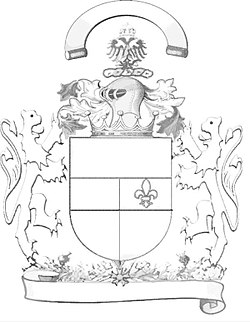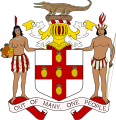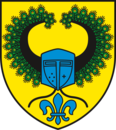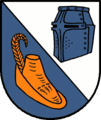Helmet (heraldry)
In heraldry, the helmet is a component of the upper coat of arms and as a coat of arms figure also in the shield .
Function and presentation

Known since the early 13th century, it has become one of the most important things in heraldry and was taken as important as the heraldic shield itself. In seals prior to that time, helmet and shield were viewed as separate things. Only the so-called helmet show at tournaments to determine chivalry has it upgraded. With the decline of chivalry, actual heraldry, the helmet has increasingly found its way into dead heraldry. Later, and then by being awarded the ruler, women and communities were given the opportunity to show the helmet on their coat of arms.
The helmet rests on the upper edge of the shield and is turned to the front of the viewer or looks to the front ( heraldic right , i.e. left in the picture - the original normal case, later only exceptions).
The helmet cover is placed on the helmet . Depending on the taste of the times, this is sometimes presented more strictly or voluminously fluttering. The top is usually colored, the bottom metallic (gold or silver). The helmet cover gives the impression of a cloth cut into strips and hanging down in a frizzy manner.
The helmet bulge or the helmet crown (in what is known later as "paper heraldry", the crown of rank corresponding to the nobility title of the family in question ) is placed on top and the other elements of the helmet decoration follow. However, economical designs are also known. This is followed by the other components of the upper coat of arms.
Heraldic helmets are shown in pale steel color. For example, they are shown in silver with a red lining on the inside. Only nobles of important families were allowed to gild the helmet and open it, i.e. leave the clasps off the helmet.
The helmet generally rests on the shield, as it was customary in the Middle Ages to tilt the shield and place the helmet on the upper left corner of the shield, which was probably also common in tournaments for presentation purposes. It is also common to place helmets next to the shield.
Originally, the helmet was used in a purely standardized form. In modern heraldry, choosing the right helmet is of particular importance: not every helmet is heraldically correct. The heraldic helmets are those that are adorned with a helmet and worn by knights at tournaments. This includes the bucket helmet and pot helmet known from the early Middle Ages . The spangenhelm or piston tournament helmet and the stech helmet play an important role. Both helmets have been known since the middle of the 15th century; their use for the coat of arms begins about a century later.
Recognizing the rank from the type and position of the helmet is only possible in France and England . Attempts in Germany were less successful. Here the noble families were given the Spangenhelm and the civil coats of arms the Stechhelm, but not consistently either. There are coats of arms of noble families with stech helmets (see picture example below of Count Isenburg). Over the different periods of time, the helmet was also common for certain groups of coats of arms. But the boundaries kept blurring. With his coat of arms reform, Napoleon tried to replace the helmet with berets decorated with feathers. His downfall also sealed this reform.
If several helmets are arranged above the shield (in post- medieval heraldry in the full coat of arms, the helmets are assembled on the combined shield in a coat of arms association ), they are turned inwards into the profile, except for the middle, highest-ranking helmet. Helmets over leaned shields are always in profile. The number increased significantly after the heyday of heraldry. The blazon of several helmets over the coat of arms takes place from the middle, alternating from the right and left of the first or middle helmet.
As a common figure - i.e. itself an element of the coat of arms - the helmet in the coat of arms is rare. There are coats of arms on which a heraldic animal is shown with a helmet attached or the helmet is attached to the shield holder .
Example helmet over the coat of arms
Depiction of a helmet with a blanket and ornaments in Scheibler's book of arms (15th to 17th centuries, here: Count Isenburg)
Full coat of arms (large coat of arms, here: Jamaica )
and that of Überlingen on Lake Constance
Crowned Spangenhelm in the coat of arms of Carinthia
Coat of arms of those of Oppenheim
Soest (Netherlands) , the only municipal coat of arms in NL with a helmet instead of a crown
Examples of helmet in the coat of arms
Pot helmet in the coat of arms of Gilgenberg am Weilhart
Looking bucket helmet in the coat of arms of Halbs
Helmet in the coat of arms of Hellmonsödt
In red a silver spangenhelm lined with red lining with a gold neck jewel and gold fittings in the coat of arms of Helmstadt-Bargen
City of Usedom repeats a helmet with ornaments in the coat of arms
Coat of arms of Ústí nad Labem with a helmet
















